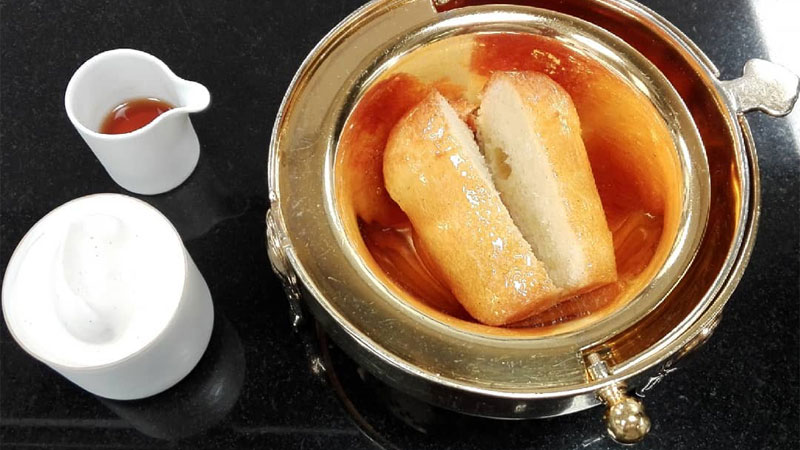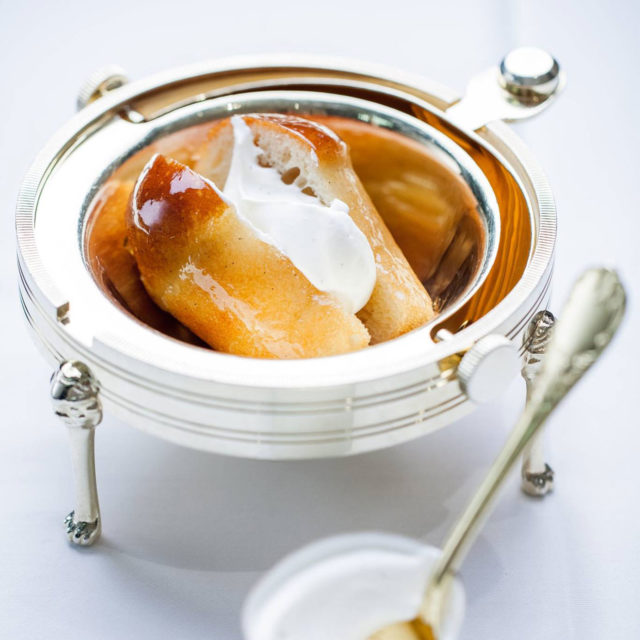It might be a French classic, but the baba au rhum (or rum baba) breaks traditional pastry rules. Enjoyed across Europe, the brioche-like cake is served soaked in liquor — usually rum — and a sometimes-flavored sugar syrup.
While most cakes aim for a light, airy, moist texture, this is exactly the opposite of the desired consistency for a perfectly baked baba au rhum. Similarly, pastry chefs typically use baking soda — or, in the case of puff pastry, steam — as a leavening agent to make a dough or batter rise. Babas, however, use yeast.
The combination of these two factors gives rum babas their unique texture and flavor. It also helps the sweet, enriched bread fulfill its raison d’être: delivering delicious, oozing bites of rum.
A few different versions of the dish’s origin exist, though most say it arrived in France via exiled Polish king Stanislas Leszczynski in the early 18th century. Leszczynski is said to have found the yeast-based kugelhopf cake of his new home city, Nancy, to be too dry; and so his pastry chef Nicolas Stohrer infused it with a rum syrup. The former king approved and named the creation after his favorite fictional character, Ali Baba.
The dessert went mainstream when Leszczynski’s daughter moved to Paris to marry King Louis XV. Stohrer moved to the capital with her and, in 1730, opened one of the city’s first patisseries. There, he introduced Parisians to the unique delight of the baba au rhum.
Nowadays, the dish is most famously endorsed by Alain Ducasse, the French chef who holds 21 Michelin stars worldwide. In 2005, Ducasse became the first chef to have three restaurants simultaneously hold three Michelin stars.
At his Louis XV restaurant, in Monte Carlo, baba au rhum is served tableside in opulent fashion, with a silver dome removed to reveal a glazed individual cake. The restaurant’s sommelier pours from a selection of fine aged rums, splits the baba in two, and scoops some lightly-whipped Chantilly cream on top.
“It’s Chef Ducasse’s favorite dessert,” says Marion Bianchini, pastry chef at Benoit, Ducasse’s NYC bistro. The dish features on the à la carte menus of many of his restaurants, she says, though not always with rum. “At Benoit, we serve it with Armagnac, which is traditional for French bistros.” (Expensive rum is the reserve of fine dining establishments, she says.)
Best practices when making rum babas include soaking the cooked cake in a warm sugar syrup for just the right amount of time, says Jansen Chan, director of pastry operations at the International Culinary Center in NYC. “If you don’t soak enough, the center isn’t always moist. But if you over-soak it, it can oversaturate and fall apart,” he says. “Once you’ve soaked for the desired time, drain until all excess syrup has been allowed to escape, and your baba is ready to go.”
Chan is another Ducasse disciple. During the three years he spent working for the French chef, Chan says he made the dessert “more times than I can probably count.” While it’s common to find recipes that see the baba soaked in a rum-infused sugar syrup, Chan advises against this so that diners can have a say in how much rum they consume.
The dessert is also common in southern Italy — in Naples in particular — where it was first introduced while the region was under French control. “When you get together with family on a Sunday, it’s traditional to bring mini babas from the local pastry shop,” says Fortunato Nicotra, the executive chef at New York institution Felidia.
The Italian restaurant has been serving babas for all of the 24 years Nicotra has worked there, though it switches the choice of liquor depending on the season. “In summer, we serve a limoncello baba because it’s more refreshing than dark rum,” he says.
At the Patisserie Chanson Dessert Bar in New York’s Flatiron District, executive pastry chef Rory Macdonald recently added an innovative take on the dessert to his six-course, omakase-style tasting menu.
Diners witness real-time soaking of a passionfruit baba in front of their faces, using a coffee siphon. Rather than simple syrup, a rum cocktail is heated to infuse the dessert. The dish is served with a banana and passionfruit sorbet, and the excess cocktail is drained and served warm as a drink pairing. “Rather than just coming out of the kitchen with a prepared rum baba, it’s nice to show people the process,” Macdonald says.

Baba au Rhum
Rum baba variations abound. This recipe produces a straightforward take flavored with orange, vanilla, and aged rum, and shaped in a traditional baba mold.
Serves 8
Ingredients:
- 1 package dry yeast
- 1/3 cup milk
- 14 ounces sifted flour
- 3 ½ ounces softened unsalted butter
- 8 ounces sugar
- 4 eggs
- Zest of 1 orange
- 1 cup aged rum
- 1 vanilla bean
- 1 cup heavy cream
Directions:
- Warm milk in a saucepan over medium heat. Once it’s heated through, transfer it to a large stainless steel mixing bowl (the liquid should be warm but not hot). Add yeast and stir until it dissolves, then stir in 1/4 cup flour. Cover, set aside in a warm place, and leave to rise for 20 minutes.
- Grease eight baba molds with butter (around ½ ounce should be enough). Place molds on a baking sheet.
- Preheat oven to 350 degrees.
- Place the remaining butter in a mixer and beat in 1 ounce of sugar and 1 ounce of flour. Add eggs, one at a time.
- Whisk in the remaining flour to create a thick, dough-like consistency, and divide equally among the baba molds. Leave to rise for around 30 minutes, or until they have doubled in size.
- As the babas rise, combine the remaining sugar with 2 cups water in a saucepan. Bring to a boil, remove from heat, and stir in orange zest. Let it cool to room temperature.
- Bake babas for 20 minutes, until golden brown on top.
- Remove from oven, leave to cool, then un-mold. Place the babas onto a dish and pour over half the orange-infused simple syrup. Allow them to soak up all of the liquid, then turn over and repeat with the rest of the syrup. Place them in the fridge to cool.
- Split the vanilla bean in half and scrape the seeds into the cream. Whip to a gentle peak and chill.
- To serve, split babas in half lengthwise, drizzle a healthy pour of your desired aged rum, and top with the lightly whipped vanilla cream.
